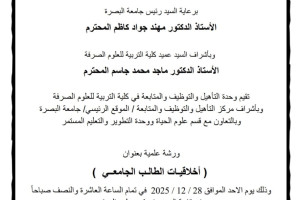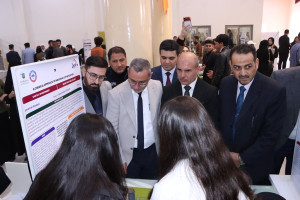
The College of Education for Pure Sciences discussed a master's thesis on a diagnostic and epidemiological study of stray cat parasites in Basra Governorate. The thesis submitted by the researcher (Rasha Jawad Kazem) included finding 13 types of parasitic worms through the dissection of 70 samples of stray cats Felis catus L. during six months from the beginning of January 2023 until the end of June 2023 from two areas in Basra Governorate, namely Shatt al-Arab District (Al-Jazeera) and the Al-Risala neighborhood area located in the center of Basra, as the total infection rate reached 98%, four of which were trematodes: Brachylaema sp.% 4.2%, Stictodora sp. 5.7%, Proceravium Calderoni %4.2%, and Hippocrepis sp. %1.4. Seven species of tapeworms: 42% Taenia taeniaforms, 57% Diplopylidium nolleri, 40% Diplopylidium acanthotetra, 35% Diplopylidium caninum, 8.5% Triodontolepis sp., 10% Choanotaenia sp., and three species of nematodes: 60% Toxocara cati, 60% Toxascaris leonina, and 17% Orneoascaris sp. All of these worms were described taxonomically, supported by illustrations and measurements, noting that seven species of them are recorded for the first time in Iraq, four species of flukes: Brachylaima sp., Stictodora sp., Procerovum Calderoni, and Hippocrepis sp., one species of nematode: Orentoscaris sp., and two species of tapeworms: Choanotaenia sp. and Triodontolepis sp. The studied cats were recorded to be infected with some parasites throughout the study period at varying rates. The study dealt with the nematode T.cati, one of the most important medically important species recorded throughout the study period. The highest number of infections was recorded in the Al-Risala neighborhood in 40 cats with an infection rate of 100% and an average infection severity of 16, while the lowest number of infections was found in the Shatt al-Arab (Al-Jazeera) area in only two cats with an infection rate of 0.06% and an average infection severity of 30. The infection rate of female and male cats in the Al-Risala neighborhood area, which reached 100% in both sexes, was higher than the infection rate of female and male cats in the Shatt al-Arab area, which reached 7.6% and 5.8%, respectively. The highest infection rate was recorded in June, reaching 70%, while the lowest infection rate was in May, reaching 35.7%. The highest infection rate was recorded in the spring season (75%) and the lowest infection rate was recorded in the winter season (30.7%). The highest infection rate was recorded in the second weight group (75%), between 3.5-2.5 kg, while no infection was recorded in the first weight group, between 2.5-1.5 kg.









